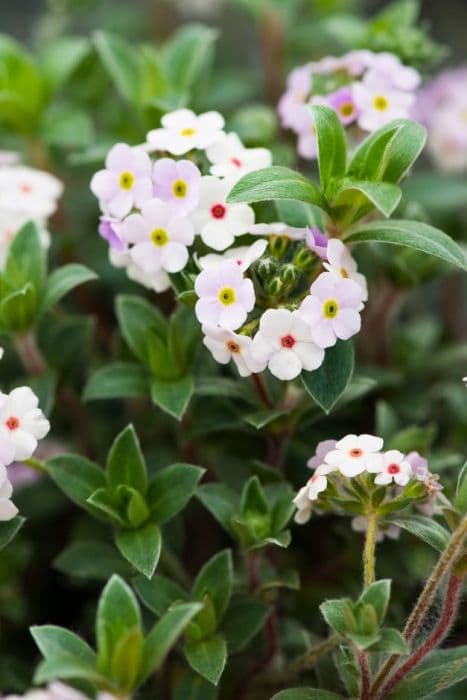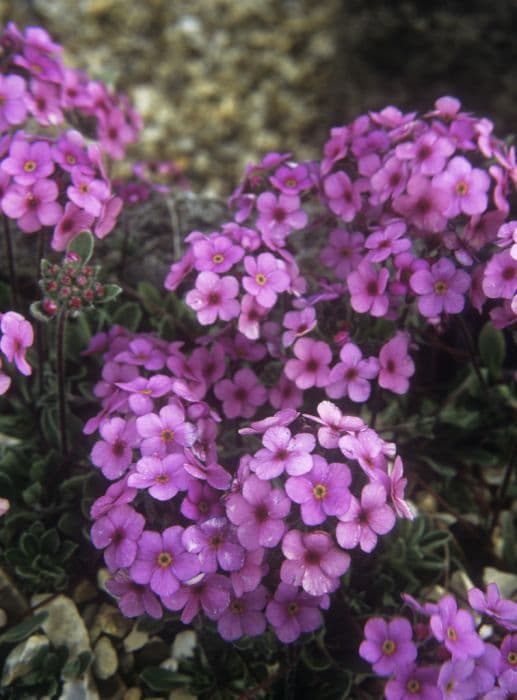Primrose Primula 'Strong Beer' (Pr/prim/d)

ABOUT
Primula 'Strong Beer', commonly known as primrose, is an attractive flowering plant that showcases a vibrant display of flowers. The blossoms emerge in hues that suggest a rich tapestry of sunset colors, often appearing in warm shades that transition from deep orange to a reddish tone, reminiscent of a hearty ale, hence the name 'Strong Beer'. The petals are rounded and slightly ruffled, giving each flower a full, lush appearance. The center of each blossom is marked by a contrasting, bright yellow eye that draws attention and adds depth to the overall floral display. The foliage of the primrose is also worthy of note. The leaves form a rosette at the base of the plant, creating a backdrop that accentuates the flowers. These leaves are typically a deep green color, and they have a somewhat crinkly texture with a slightly wavy edge. This offers visual interest even when the plant is not in full bloom. Overall, the primrose 'Strong Beer' is valued for its vividly colored flowers and decorative leaves, making it a delightful addition to gardens designed for visual impact. The plant radiates a charm that can enhance various garden settings, from borders to container arrangements. Its appearance signifies the arrival of spring, as it is often one of the first plants to bloom when the weather turns warmer.
About this plant
 Names
NamesFamily
Primulaceae
Synonyms
Strong Beer Primrose
Common names
Primula denticulata, Primula rosea, Primula vulgaris, Primula veris.
 Toxicity
ToxicityTo humans
Primula 'Strong Beer' or Primrose is not considered highly toxic to humans. However, some people may experience mild discomfort if they ingest parts of the plant or handle it without gloves. Symptoms could include nausea, vomiting, or diarrhea if ingested, and contact with the skin may result in dermatitis or irritation for those with sensitive skin or allergies to the plant.
To pets
Primrose is also not highly toxic to pets, but it can cause mild gastrointestinal upset if ingested. Common symptoms in pets might include vomiting, diarrhea, and drooling. Contact with the plant may also cause skin irritation in some animals. As with any non-food plant, it is advisable to prevent pets from consuming Primroses to avoid potential discomfort.
 Characteristics
CharacteristicsLife cycle
Perennials
Foliage type
Evergreen
Color of leaves
Green
Flower color
Yellow
Height
6 inches (15 cm)
Spread
1 foot (30 cm)
Plant type
Herb
Hardiness zones
5
Native area
Europe
Benefits
 General Benefits
General Benefits- Aesthetic Appeal: Adds vibrant color and visual interest to gardens and containers with its deep maroon to beer-colored flowers.
- Extended Bloom Period: Offers a long flowering season, typically blooming from late winter through spring, which enriches the garden during a time when few other plants are in flower.
- Low Maintenance: Requires minimal care once established, making it a good choice for gardeners of all skill levels.
- Cold Tolerant: Capable of surviving and thriving in cooler temperatures, making it suitable for planting in a variety of climates.
- Compact Size: With its small stature, it fits well into smaller garden spaces or as an underplanting in larger landscape designs.
- Attracts Pollinators: Flowers attract bees and butterflies, supporting local ecosystems and promoting biodiversity.
- Edging and Border Plant: Its compact growth habit and colorful flowers make it an excellent choice for edges and borders in the garden.
- Container Gardening: Well-suited for container gardening, which allows for flexibility in placement and makes it accessible for those with limited garden space.
 Medical Properties
Medical PropertiesThis plant is not used for medical purposes.
 Air-purifying Qualities
Air-purifying QualitiesThis plant is not specifically known for air purifying qualities.
 Other Uses
Other Uses- As a Natural Dye: The flowers of primroses can be used to create a gentle yellow to green natural dye for fabrics.
- Eco-Friendly Confetti: Dried primrose petals can serve as biodegradable confetti for outdoor celebrations, reducing the environmental impact.
- Edible Garnish: Primrose flowers add color and a mild flavor to salads and desserts when used as an edible garnish.
- Crafting Potpourri: Dried primrose flowers can be included in homemade potpourri mixes to impart a fragrant aroma to indoor spaces.
- Floral Art: The vibrant colors of primrose flowers can be used for floral displays and botanical art, such as pressing for framed artwork.
- Garden Compost Ingredient: Spent primrose plants can be added to garden compost piles to contribute to the creation of nutrient-rich soil.
- Natural Insect Deterrent: Some believe that planting primroses may help to repel certain garden pests due to their natural scent.
- Frozen Flower Ice Cubes: Freezing primrose flowers in ice cubes can add an elegant touch to drinks served at special events.
- Homemade Flower Jelly: The blooms can be used to make a mild-tasting flower jelly that can be spread on toast or scones.
- Candle Decoration: The petals can be embedded in the wax of handmade candles to create a decorative and fragrant light source.
Interesting Facts
 Feng Shui
Feng ShuiThe Primrose is not used in Feng Shui practice.
 Zodiac Sign Compitability
Zodiac Sign CompitabilityThe Primrose is not used in astrology practice.
 Plant Symbolism
Plant Symbolism- Youthful charm: The primula often signifies the freshness and innocence of youth due to its bright and early blooming.
- Renewal: As one of the first flowers to bloom at the end of winter, it symbolizes new beginnings and the renewal that comes with spring.
- Hope: Its emergence after cold months provides a sense of hope and the anticipation of warmer days ahead.
- Love and admiration: Giving someone primulas can express a kind of genteel love or admiration for their character.
- Protection and safety: In some traditions, primulas are thought to ward off evils and bring safety to a household.
 Water
WaterThe English Primrose, also known as Primula 'Strong Beer', should be watered regularly to maintain moist but not waterlogged soil. Typically, this could mean watering the plant with about half a gallon of water every week, but the frequency may need to increase during hot, dry periods or if the plant is in a pot. It is important to use lukewarm water and to water the plant at its base to avoid wetting the leaves, which can lead to fungal diseases. During the winter, when the plant is not actively growing, reduce watering to avoid root rot but do not let the soil dry out completely.
 Light
LightEnglish Primroses prefer bright but indirect light. They thrive in a location that receives morning sun and afternoon shade, or a spot with dappled sunlight throughout the day. Direct afternoon sunlight, especially in hotter climates, can scorch the delicate leaves of the plant.
 Temperature
TemperatureIdeal temperature conditions for an English Primrose are between 50°F and 70°F. While they can withstand temperatures down to around 0°F, they shouldn't be exposed to harsh, prolonged freezes. During the summer, it's best to keep them in a cooler environment as prolonged exposure to temperatures above 80°F can be detrimental.
 Pruning
PruningEnglish Primroses benefit from deadheading, which involves removing spent flowers to encourage further blooming and to keep the plant looking tidy. Pruning is also needed to remove any dead or yellowing leaves. The best time for pruning is immediately after the plant finishes flowering, and regularly throughout the blooming season for deadheading.
 Cleaning
CleaningAs needed
 Soil
SoilPrimroses including 'Strong Beer' prefer a rich, well-draining soil with plenty of organic matter. A mix of peat, garden soil, and perlite or sand works well, mimicking their natural woodland environment. The ideal soil pH for Primrose 'Strong Beer' is between 6.0 and 7.0, slightly acidic to neutral.
 Repotting
RepottingPrimroses like 'Strong Beer' should be repotted every 1 to 2 years or when they outgrow their current container. Best done after flowering, repotting helps to refresh the soil, provide more space, and encourage healthy growth.
 Humidity & Misting
Humidity & MistingPrimroses such as 'Strong Beer' favor moderate to high humidity levels, ideally between 50-70%. They thrive in a moist environment that replicates their native woodland habitat, but can tolerate slightly lower humidity levels indoors.
 Suitable locations
Suitable locationsIndoor
Keep in indirect light, moderate water, and high humidity.
Outdoor
Plant in partial shade, moist soil, and shelter from wind.
Hardiness zone
5-9 USDA
 Life cycle
Life cyclePrimrose 'Strong Beer' begins its life cycle as a dormant seed, requiring cold stratification to break dormancy and germinate. Upon germination, it develops into a rosette of leaves at the soil surface, during which root establishment and vegetative growth occur. The plant then enters a vegetative state where it focuses on leaf growth to garner energy through photosynthesis. Following vegetative growth, it initiates reproductive growth, producing flower stalks topped with vibrant flowers that attract pollinators for sexual reproduction. After successful pollination, it forms seeds which disperse to begin the life cycle anew. During harsh conditions or winter months, Primrose 'Strong Beer' may die back to the ground, only to emerge again from its hardy rootstock with the return of favorable growing conditions.
 Propogation
PropogationPropogation time
Spring-Early Summer
Primula 'Strong Beer', commonly known as Primrose, is typically propagated through division, which is a process best carried out in late summer to early fall, after the blooming period has ended and the plant has become well-established. To propagate by division, gently lift the plant from the soil and tease apart the clumps into smaller sections, ensuring that each section has a portion of the root system attached. These divisions can then be replanted in a moist, well-drained soil mix at a spacing that allows for future growth, around 6 to 12 inches apart (approximately 15 to 30 centimeters). Water the new plants thoroughly after planting to settle the soil around the roots and help reduce transplant shock. With proper care, these divisions will establish themselves quickly and can be expected to bloom in the following spring.









